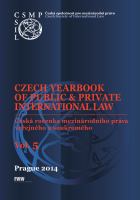

ANA POLAK PETRIČ
CYIL 5 ȍ2014Ȏ
rights in disaster situations. They base their argumentation on the fact that sovereignty
and territorial integrity, which are the guiding principles in the coordination of
humanitarian assistance, also entail duties of a State towards its citizens, including that
of protection. Therefore, the principles of sovereignty and non-intervention cannot
serve as an excuse to act in a manner that denies victims access to assistance. Thus, if
the affected State cannot discharge its obligation to provide timely relief to its people
in distress, it must have an obligation to seek outside assistance.
25
The opposition to
the existence of the right to humanitarian assistance in international law and practice
bases its conclusions on the recognition that this right could imply the ‘right to
impose humanitarian assistance’ on the affected State that does not want it, which
would be in conflict with the principles of sovereignty and non-intervention, and the
need for consent of the affected State for the provision of humanitarian assistance on
its territory. The right to humanitarian assistance could be therefore easily abused and
give rise to double standards.
26
As a general legal principle, State sovereignty and the
principle of consent should prevail, and all States have a legitimate right to accept or
refuse humanitarian assistance and to choose the donor according to their interests.
This clearly shows that there is no uniform view on the question on the existence of
the right of victims to humanitarian assistance in the event of natural disasters. According
to article 38 of the Statute of the International Court of Justice, international law can
be established from various sources. As any other legal rule, the right to humanitarian
assistance draws its substance from all of them, with some offering more material
and substance than others. The intention of the next chapter is to briefly inspect and
identify each individual source of international law that could confirm the existence
of this right.
3.1 The existing legal regime (de lege lata)
Legally binding expression of the right to humanitarian assistance during natural
disasters is not altogether absent. Non-binding documents have long been calling
for the recognition of this right, and today we are witnessing the first examples of
modern legal instruments referring to the right to humanitarian assistance while
aiming to protect the lives and other basic human rights of the most vulnerable
individuals. An explicit reference to the right to humanitarian assistance, which was
until recently virtually non-existent in ‘hard law’ and multilateral treaties, is included
in the Convention for the Protection and Assistance of Internally Displaced Persons
in Africa (Kampala Convention).
27
This is the first legally binding instrument in the
world that, although limited as regards the claimant to internally displaced persons,
not only unambiguously refers to the right to protection and assistance but takes
a clearly progressive approach towards the obligations of States in ensuring this right.
Article 5 (9) of the Convention reads as follows:
25
ILC, Report on the Work of its sixtieth session, UN Doc A/63/10, paras. 241, 243-244.
26
ILC, Provisional summary record of the 2980th meeting, UN Doc A/CN.4/SR.2980, pp. 10-11.
27
Available at:
http://www.internal-displacement.org/kampala-convention.















